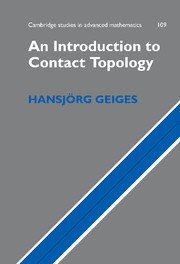Book contents
- Frontmatter
- Contents
- Preface
- 1 Facets of contact geometry
- 2 Contact manifolds
- 3 Knots in contact 3—manifolds
- 4 Contact structures on 3—manifolds
- 5 Symplectic fillings and convexity
- 6 Contact surgery
- 7 Further constructions of contact manifolds
- 8 Contact structures on 5—manifolds
- Appendix A The generalised Poincaré lemma
- Appendix B Time-dependent vector fields
- References
- Notation index
- Author index
- Subject index
7 - Further constructions of contact manifolds
Published online by Cambridge University Press: 05 November 2009
- Frontmatter
- Contents
- Preface
- 1 Facets of contact geometry
- 2 Contact manifolds
- 3 Knots in contact 3—manifolds
- 4 Contact structures on 3—manifolds
- 5 Symplectic fillings and convexity
- 6 Contact surgery
- 7 Further constructions of contact manifolds
- 8 Contact structures on 5—manifolds
- Appendix A The generalised Poincaré lemma
- Appendix B Time-dependent vector fields
- References
- Notation index
- Author index
- Subject index
Summary
‘Maybe I'm an open book…’
Sheena Easton, For Your Eyes OnlyContact surgery, as we have just seen, is a powerful method for constructing contact manifolds, but by far not the only one. Concerning 3—manifolds, we saw in Section 4.4 that it is also possible to find contact structures with the help of open books and branched coverings. In Sections 7.3 and 7.5, respectively, we extend these two methods to contact manifolds of arbitrary dimension. The deep relation between open books and contact structures was discovered by Giroux. One of the remarkable applications of open books is the construction, due to Bourgeois, of contact structures on all odd-dimensional tori. The compatibility of contact structures with branched coverings in arbitrary dimensions was first observed by Gromov.
Before the advent of topological techniques for the construction of higher-dimensional contact manifolds, two methods of a more geometric nature had been used extensively: the explicit description of a contact form on Brieskorn manifolds, which we shall discuss in Section 7.1, and the contact form given by the connection 1—form on suitable principal S1—bundles (Boothby—Wang construction), as described in Section 7.2.
In Section 7.4 I present the fibre connected sum of contact manifolds. This construction was originally suggested by Gromov, both for symplectic and contact manifolds.
- Type
- Chapter
- Information
- An Introduction to Contact Topology , pp. 332 - 365Publisher: Cambridge University PressPrint publication year: 2008

